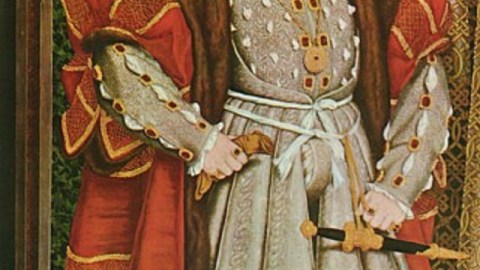Where Weinergate Stands in a Long (and Strange) Visual Tradition

New York Democratic Congressman Anthony Weiner’s misadventures with his digital camera, Twitter account, and boxers have given us yet another “-gate”— Weinergate. But Weiner’s not the first male figure in power to make some display of his nether regions in a confusion of sexual and political power. Long before tweeting and sexting, kings secular (and sacred) made a point with their genitalia that contributed to a tradition that Weiner’s just the latest, strangest, and saddest to join.
When I first heard of Weiner’s bulging underwear picture, I flashed back to Hans Holbein the Younger’s Portrait of Henry VIII from 1536. Holbein’s painting fell victim to fire in 1698, but enough copies remain to give a sense of the original. Henry VIII distributed copies to friends and visiting dignitaries, hoping that this idealized portrait would linger in their minds longer than the impression his failing health may have left in person. In the full length portrait, Henry proudly stands with hands on hips and his (insufficiently depicted) weight balanced on his widely spread legs. At the center of the image, however, is the star of the show—the bulging codpiece that Anne Boleyn lost her head figuratively over a few years before and lost her head over literally just earlier that year (detail shown). With Jane Seymour and the promise of male issue (which would turn out to be the future Edward VI) waiting in the wings, Henry desperately needed to assert his sexual power and the role that sexuality played in maintaining the Tudor dynasty. Holbein knew this and gave proper prominence to the codpiece, and even added a phallic dagger in Henry’s left hand just in case you missed the point.
Years later, Anthony Van Dyck became court painter to one of Henry VIII’s successors, Charles I of England. Van Dyck’s portraits aren’t as “front and center” as Holbein’s Henrys, but they do compensate and overcompensate in a different way. The diminutive ruler needed to be larger than life, so Van Dyck obliged in works such as 1633’s Charles I with M. de St. Antoine. To hide Charles’ vertical challenge, Van Dyck placed him on a horse. The raging stallion between Charles’ legs, however, did more than add to the king’s stature, of course. That white horse became Charles’ bulging codpiece, the oversized symbol of his sexual and political power. Then, as now, male political figures knew that size matters.
But even the King of Kings drew visual power from His manhood. As the late Leo Steinberg’s 1983 book, The Sexuality of Christ in Renaissance Art and in Modern Oblivion, argued, many images of Jesus Christ as an infant emphasized his genitalia. No genitalia, no humanity—or so the visual argument went. Just to hammer the idea home, other figures in the paintings often would point a helpful finger in the direction of the young savior’s bulge. Steinberg supported his argument with an almost embarrassing trove of visual proof.
Secular kings claimed divine right as the source of their power, so it seems natural that they would follow the same manifestations of that power as a divine figure such as Jesus. If proto-sexting was good enough for Jesus to prove his manhood, then it was good enough for Henry, Charles, and all the others. Today, self-proclaimed “kings” in their fields such as Weiner and Brett Favre flaunt their pornographic codpiece equivalents electronically. Holbein, Van Dyck, and other artists took an earthy argument and softened the crude edges. Sadly, Weinergate and Favregate argue only for men with poor judgment not to get Twitter accounts if that poor judgment already involves what’s inside their pants.
[Image:Hans Holbein the Younger. Portrait of Henry VIII (detail). 1536.]





